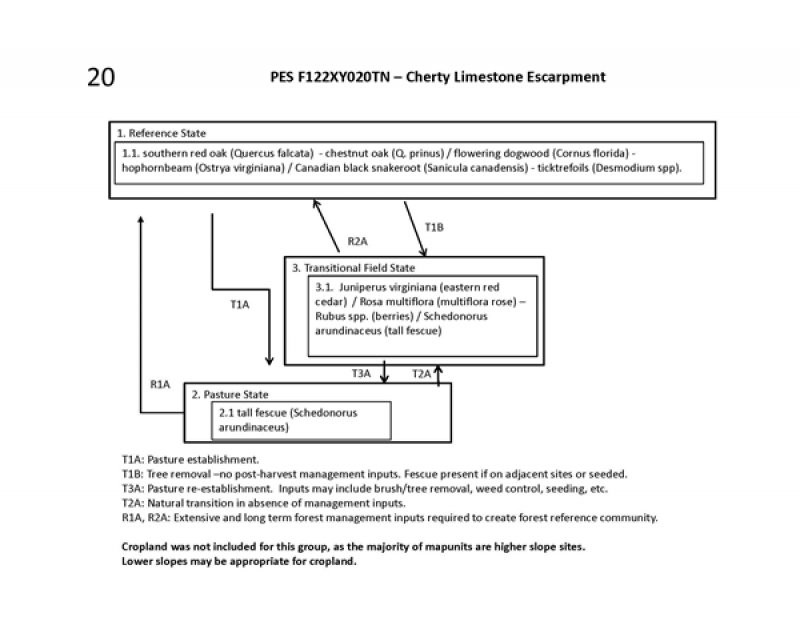
Natural Resources
Conservation Service
Ecological site F122XY020TN
Cherty Limestone Escarpment
Last updated: 5/14/2025
Accessed: 12/21/2025
General information
Provisional. A provisional ecological site description has undergone quality control and quality assurance review. It contains a working state and transition model and enough information to identify the ecological site.
MLRA notes
Major Land Resource Area (MLRA): 122X–Highland Rim and Pennyroyal
MLRA 122 is in Tennessee (47 percent), Kentucky (43 percent), Indiana (7 percent), and Alabama (3 percent). It makes up about 21,530 square miles (55,790 square kilometers).
SOILS:
Many of the soils in this MLRA are Udalfs. The moderately deep to very deep, well drained, clayey soils formed in limestone residuum. They are dominantly in rolling to steep areas of the “Outer Basin” (Mimosa, Braxton, Gladdice, and Hampshire series) and the undulating to hilly areas of the “Inner Basin” (Talbott and Bradyville series). The most agriculturally productive soils are the very deep, well drained, clayey or loamy soils that formed in alluvium and/or loess over alluvium or limestone residuum in nearly level to undulating areas (Armour, Cumberland, Harpeth, Lomond, and Maury series). The less extensive soils generally are moderately well drained to somewhat poorly drained and formed in loamy or clayey alluvium and/or residuum (Byler, Capshaw, Colbert, and Tupelo series). This MLRA has a significant acreage of Mollisols. Shallow or moderately deep, well drained, clayey Udolls (Ashwood and Barfield series) formed in limestone residuum dominantly in rolling to steep areas. Very shallow, well drained, clayey Rendolls (Gladeville series) formed in limestone residuum dominantly in undulating to rolling areas of the “Inner Basin.” Very deep, well drained or moderately well drained Udolls (Arrington, Egam, Lynnville, and Staser series) and somewhat poorly drained or poorly drained Aquolls (Agee, Godwin, and Lanton series) formed in loamy or clayey alluvium derived from limestone on flood plains. Most of the remaining soils on flood plains are moderately well drained or well drained Udepts (Lindell and Ocana series). Udults are of small extent in this area. Most are very deep, well drained, and loamy and formed in gravelly colluvium or colluvium and the underlying residuum on steep hillsides (Dellrose soils).
BIOLOGICAL RESOURCES:
This area supports mixed oak forest vegetation. White oak, black oak, northern red oak, and some scarlet oak are the dominant tree species. Shagbark hickory, bitternut hickory, pignut hickory, and mockernut hickory also occur. Oak, blackgum, flowering dogwood, sassafras, Virginia pine, pitch pine, and shortleaf pine grow mostly on ridgetops.
(Excerpt from United States Department of Agriculture, Natural Resources Conservation Service. 2006. Land Resource Regions and Major Land Resource Areas of the United States, the Caribbean, and the Pacific Basin. U.S. Department of Agriculture Handbook 296.)
Classification relationships
Scientific Name: Southern Interior Low Plateau Dry-Mesic Oak Forest, Unique Identifier: CES202.898
Ecological site concept
This PES describes plant communities likely to be found on these soils but does not encompass the entire complexity or diversity of these sites. Future field work is required to develop ecological site descriptions (ESDs) which can be utilized for conservation and planning purposes. Multiple ESDs may be developed from this initial grouping.
Common trees as listed in NASIS and county soil surveys for this group include:
southern red oak, white oak, black oak, scarlet oak, chestnut oak, blackgum, sourwood, yellow poplar, hickories, shortleaf pine, loblolly pine, and eastern red cedar.
Only two tree species can be selected for entry into the database as dominants; however, multiple tree species may be dominant on these sites depending on aspect, soil depth, seed sources, management, and disturbance history.
State 1. Forestland
Phase 1.1: Plant species dominants:
southern red oak (Quercus falcata) - chestnut oak (Q. prinus) / flowering dogwood (Cornus florida) - hophornbeam (Ostrya virginiana) / Canadian black snakeroot (Sanicula canadensis) - ticktrefoils (Desmodium spp).
State: 2. Pasture
Phase 2.1: Managed Pasture. Plant species dominants: Schedonorus arundinaceus (tall fescue)
Pasture plant species are dependent on seeding, weed control, concurrent land uses, on-going levels of disturbance, and landowner goals. Individual site and soil characteristics, along with management activities, will influence production levels.
State: 3 – Transitional (Abandoned Field)
Phases 3.1: Plant species dominants: eastern red cedar (Juniperus virginiana)/ multi-flora rose (Rosa multiflora) – berries (Rubus spp.) / tall fescue (Schedonorus arundinaceus)
Tree species regeneration on these sites will depend on the severity and duration of disturbance, soil characteristics, adjacent plant communities and seed sources, post-disturbance management inputs, presence or absence of continued site disturbances (grazing), slope, and aspect.
Lower slope mapunits may be used for cropland, but pasture and woodlands are the predominant uses of these site.
Associated sites
| F122XY022TN |
Gravelly Colluvial Footslopes Gravelly Colluvial Footslopes |
|---|
Table 1. Dominant plant species
| Tree |
(1) Quercus falcata |
|---|---|
| Shrub |
(1) Cornus florida |
| Herbaceous |
(1) Sanicula canadensis |
Click on box and path labels to scroll to the respective text.
